This article was published in Scientific American’s former blog network and reflects the views of the author, not necessarily those of Scientific American

A few short weeks ago the.... umm... fifth (I think) international pterosaur meeting was held. It was hosted by my alma mater the University of Portsmouth, was run by Dave Martill, Richard Hing and colleagues, and was attended by a great crowd of international pterosaur workers. In previous years I’ve written about at least two pterosaur-themed meetings (see links below), and I aim here to discuss just a few of the subjects covered at this latest meeting.
A major theme that loomed large throughout concerned the biology, ecology, phylogeny, systematics and diversity of ‘early pterosaurs’: the non-pterodactyloids or ‘rhamphorhynchoids’. This is a group of animals that I’ve never written much about – partly because I’ve just never gotten round to it, but also partly because my colleague Mark Witton has written a lot of good stuff on them already. The relationships among the many lineages concerned remain unsettled and several markedly different hypotheses are currently on the table.
On supporting science journalism
If you're enjoying this article, consider supporting our award-winning journalism by subscribing. By purchasing a subscription you are helping to ensure the future of impactful stories about the discoveries and ideas shaping our world today.
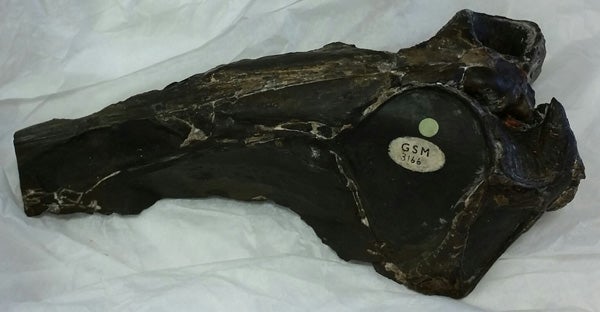
The robust (and really heavy) holotype skull of Parapsicephalus, one of several pterosaur specimens available for examination at the meeting. Photo by Darren Naish.
A set of Triassic taxa that have multi-cusped cheek teeth – the eudimorphodontids and/or campylognathoidids – are posited as one of the earliest pterosaur lineages to evolve by some workers (like Brian Andres and Steven Vidovic) but as being far closer to pterodactyloids by others (like David Unwin). And specimens previously assumed to belong to Eudimorphodon have recently been the subject of revision by Alex Kellner who spoke about his recent naming of Arcticodacylus, Austriadraco and Bergamodactylus (Kellner 2015).
Interest in Dimorphodon is really undergoing something of a renaissance at the moment. Mark Witton presented a new integrated view of this pterosaur’s anatomy and biology. The idea of it as a sort of ‘puffin pterosaur’ is not well founded at all – several lines of data indicate that it was actually highly terrestrial and with poor flight abilities compared to most of its relatives.
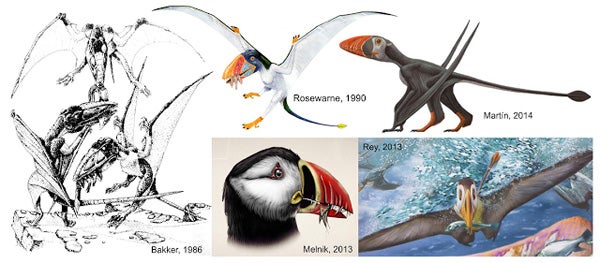
Dimorphodon has often been visualised as a 'Puffinodon', as confirmed by this montage (compiled by Mark Witton). But we need to give up on this. For more discussion see Mark's article here.
Steve Vidovic told us his really intriguing idea that anurognathids might be paedomorphic scaphognathines (or scaphognathids, if you prefer). I don’t think he’s right, but it sure is intriguing. Anurognathids remain one of the most perplexing pterosaur groups of all and they possess a curious mix of anatomical features. There are thrilling and (arguably) terrifying rumours about a new anurognathid discovery, soon to be announced.
When non-pterodactyloid monofenestratans ruled the skies
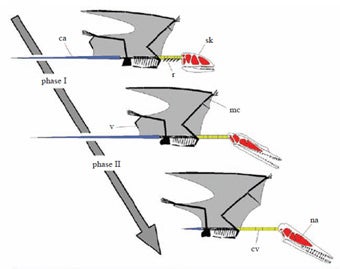
Darwinopterus (the middle animal in this sequence): a good example of modular evolution. Image from Lü et al. (2010).
Moving on, Darwinopterus from the Middle or Upper Jurassic Tiaojishan Formation of Liaoning Province, China, continues to be a pivotal taxon as goes our developing understanding of pterosaur evolution and biology. As is well known, Darwinopterus seemingly combines anatomical traits of pterodactyloids in its skull with non-pterodactyloid features in the wrist, feet and elsewhere. This composite anatomy indicates that so-called modular evolution was important in the early evolution of the lineage that led to pterodactyloids, the largest and most successful pterosaur group (Lü et al. 2010). Accordingly, Darwinopterus was – when first published – posited as a key ‘intermediate’ taxon between long-tailed, five-toed pterosaurs like the rhamphorhynchids and the short-tailed, four-toed pterodactyloids (Lü et al. 2010).
Fans of the Pterosauria will know that Darwinopterus may well not be the sole occupant of its particular branch on the pterosaur tree: a bunch of other, similar taxa have now been identified from diverse locations. Some people call these wukongopterids (after Wukongopterus from the Middle or Upper Jurassic Daohugou Beds of China), and others term them darwinopterans or darwinopterids. Dave Unwin explained ongoing work which argues that several pterosaurs originally described as belonging elsewhere may at least be members of the same ‘grade’ as Darwinopterus. That is, they may be non-pterodactyloid monofenestratans (Monofenestrata being the clade named for the Darwinopterus + Pterodactyloidea node).

Holotype skull of Cuspicephalus scarfi, also brought along to the meeting. The skull is 32 cm long. Photo by Darren Naish.
Cuspicephalus from the English Kimmeridge Clay was recently reinterpreted as an animal of this sort by Witton et al. (2015). Incidentally, the Cuspicephalus holotype specimen was on display at the meeting. Oh, look, I just said that in the caption.
The azhdarchoids
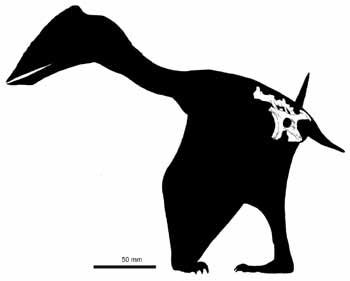
Speculative silhouette of Vectidraco as the whole animal might have looked; image from Naish et al. (2013).
Back in 2013, I and colleagues described the new small pterosaur Vectidraco daisymorrisae (based only on a pelvis and its associated vertebrae) from the Vectis Formation of the Isle of Wight (Naish et al. 2013). I’m pleased to say that this animal was the subject of two presentations. The first was by Rachel Frigot and looked at muscle attachment sites on the specimen and what they might tell us about pterosaur biomechanics. And the second was by Liz Martin-Silverstone and concerned an in-prep study (also involving myself and Dan Sykes) on the detailed anatomy of this animal. It turns out that structures originally identified (Naish et al. 2013) as pneumatic foramina are not pneumatic foramina... they’re actually spinal nerve foramina (what a silly mistake). There’s a whole story here that I’ll discuss once the project is closer to publication. Until then, you can get some idea of where we’re going by reading Liz’s excellent article here.
Incidentally, the phylogenetic hypothesis that we initially favoured for Vectidraco – that it’s an azhdarchoid, allied in some way to tapejarids – has been supported by other workers (though the relevant conclusions are unpublished, I think). Many provincial fossil taxa named on the basis of scrappy remains are nice additions to our understanding of distribution and diversity but all too often have little to say about big picture stuff. At the moment I like to think that Vectidraco may well be different – it’s already proving quite instrumental as goes several unconnected research strands.
What about the best azhdarchoids, and best pterosaurs of all... the azhdarchids? James Brown had a really neat poster on the neurovascular anatomy of azhdarchid jaws from Morocco (probably referable to Alanqa). The relevant details are most comparable to those of cranes.
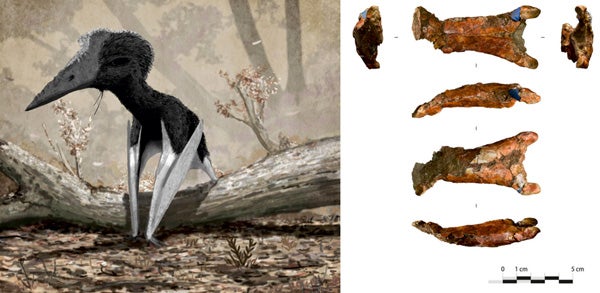
Recently discovered specimens show that some azhdarchids - like the unnamed animal from Pui in Romania, shown here - had mid-cervicals only twice as long as they are at their widest point (as opposed to the 2.5 to 4 times longer seen in 'typical' taxa). Reconstruction by Mark Witton. Images of the fossil from Vremir et al. (2015).
And, indeed, this seems to fit a theme that might be familiar to readers of this blog – this being that the new bits of data that come in on azhdarchids are consistent with the Witton & Naish (2008) terrestrial stalking model. Not with aerial scoop-netting (see Witton & Naish 2015), or sediment-probing, or skim-feeding, or obligate scavenging, or aerial predation, or heron-like wading. My own talk was on where we are right now as goes the copious new azhdarchid material from the latest Cretaceous of Romania. It seems that azhdarchids were more variable in proportions, and perhaps ecology and behaviour, than thought before, with long-necked and (comparatively) short-necked taxa, and small and large taxa, living in sympatry (Vremir et al. 2013, 2015). There’s a bigger story here which I’ll cover once an in-press paper sees publication.
So much biomechanics
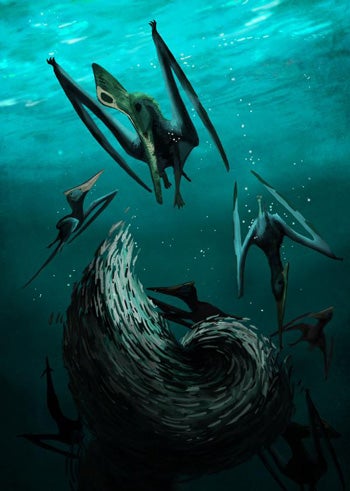
Could Pteranodon dive and swim, as shown in this reconstruction by Mark Witton? Data says... maybe yes.
One of my personal highlights of the meeting was Mike Habib’s talk on plunge diving and surface foraging in Pteranodon and other pterosaurs. If you’ve been paying attention you might know that there’s been serious consideration for a while now that pteranodontids and other oceanic pterosaurs may well have been capable of plunging and even foraging beneath the surface (e.g., Bennett 1994, Witton 2013). Mike’s quantitative work on biomechanics shows that all of those ideas about pteranodontids being too light or too fragile or too wingy or whatever to perform in, on and under water are probably nonsense. The maths for water launching works out (Habib & Cunningham 2010) and the skeleton could easily withstand impact with water, more so if we postulate a subdermal air sac system like that in some plunge-diving seabirds (like gannets). There are, of course, energetic limits on water-launching, and these might have imposed a size constraint on marine pterosaurs.
And I can’t mention biomechanics without telling you about the biomechanics workshop that Mike ran together with Colin Palmer. It ran in freestyle fashion and people could come and go as they pleased..... aaaand it ended up going on for five hours. This was voluntary – and it was brilliant.

Scenes from the biomechanics workshop. Colin Palmer at left; Mike Habib at right. Photos by Darren Naish.
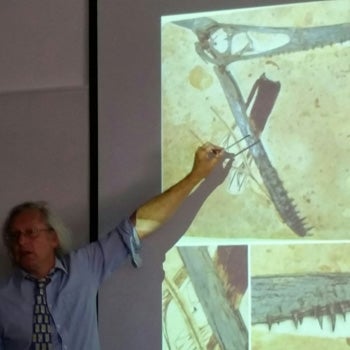
Dave Martill talks about Ludodactylus (a Brazilian pterosaur that seems to have a leaf wedged between the two halves of its lower jaw) in one of the workshop sessions.
There was, of course, much else besides what I’ve discussed here. Work on new pterosaur taxa and specimens from around the world was presented; there were talks and posters on ontogeny, phylogeny, soft tissues, and on big issues of pterosaur macroevolution and whole-taxon databases. Those seriously interested and unable to attend should make some effort to obtain the very nicely produced abstract volume. My congratulations to the organisers for a great meeting, and I look forward to the next one – I think being held in sunny Los Angeles!
For previous articles relevant to various of the subjects covered here, see...
A new azhdarchid pterosaur: the view from Europe becomes ever more interesting
Daisy's Isle of Wight Dragon and why China has what Europe does not
Refs - -
Bennett, S. C. 1994. The pterosaurs of the Niobrara Chalk. The Earth Scientists 11, 22-25.
Witton, M. P. 2013. Pterosaurs: Natural History, Evolution, Anatomy. Princeton University Press, Princeton and London.